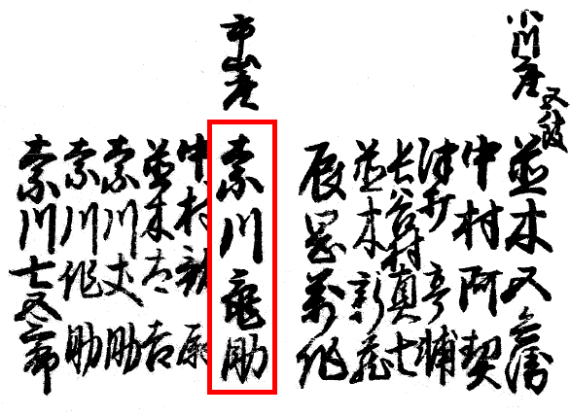| NAGAWA KAMESUKE I |
|
Playwright names:
Line number: SHODAI (I) Existence: ??? ~ ??? Connection: Master: Namiki Sh˘z˘ I Disciples: Nagawa Shimesuke I, Nagawa Shinz˘, Nagawa Sanbu Career: Before 1771: son of a Nara merchant, he became a disciple of Namiki Sh˘z˘ I but did not receive a Namiki name. He called himself Nagawa Kamesuke [1]. 11th lunar month of 1771: Kamesuke worked at the Naka no Shibai, along with his master Namiki Sh˘z˘ I, on the kaomise drama "Temomutsumajiya Ryűgű no Shimadai", which also celebrated the shűmei of Arashi Bungor˘ I, Ichikawa Otojűr˘ and Arashi Shichisabur˘ II. Summer 1773: Kamesuke became tatesakusha in ďsaka. 4th lunar month of 1775: premiere in ďsaka at the Naka no Shibai of Kamesuke's drama "Hade Kurabe Ise Monogatari" [more details]. 11th lunar month of 1775: Kamesuke was tatesakusha at the Naka no Shibai, where he worked on the kaomise drama "Gohiiki Tenmokuzan", which was produced by Mimasu Matsunoj˘. 12th lunar month of 1776: premiere at the Naka no Shibai of Kamesuke's drama "Igagoe Norikake Gappa" [casting]. 4th lunar month of 1777: premiere in ďsaka at the Naka no Shibai of Kamesuke's drama "Meiboku Sendai Hagi" [casting]. 11th lunar month of 1777: Kamesuke and Nagawa Shimesuke I worked on the kaomise drama "Daijizai Kaminari no Kodakara", which was produced at the Naka no Shibai by the zamoto Ichiyama Tajir˘, celebrated the shűmei of Yamashita Kamenoj˘ IV and welcomed back in ďsaka Arashi Sangor˘ II after 3 and 7 seasons spent in Ky˘to and Edo. 12th lunar month of 1781: Kamesuke's drama "Katakiuchi Tengajaya-mura" was staged for the first time, in ďsaka at the Kado no Shibai [casting]. A similar play was staged a few days later under a different title, "Renga Chaya Homare no Bundai", written by his disciple Nagawa Shimesuke I, who became tatesakusha at the Naka no Shibai [casting], opening a competition between the two theaters for the best performance and the best line-up. The performance at the Kado no Shibai was a huge success and a long run. Unfortunately for Nagawa Shimesuke I, the performance at the Naka no Shibai was a commercial failure. 11th lunar month of 1784: Kamesuke worked at the Naka no Shibai on the kaomise drama "Naka ni M˘keta Otogo Kaomise", which was produced by Nakamura Kumetar˘ II and welcomed in ďsaka the Edo star Matsumoto K˘shir˘ IV [2]. 1st lunar month of 1785: he temporarily took the name of Nagawa Eich˘d˘ and held it for a short period of time before taking back the name of Nagawa Kamesuke. 5th lunar month of 1785: he worked at the Naka no Shibai on the drama "Na ni ďsaka K˘raiya Bashi". No record afterwards. Comments: Nagawa Kamesuke I was an important Kamigata sakusha, the founder of the Nagawa clan, who was active only from the middle of the beginning of the 1770s to the middle of the 1780s and who took part in the creation of more than 70 Kabuki dramas, including "Meiboku Sendai Hagi", "Tengajaya" or "Hade Kurabe Ise Monogatari" which were still part of the Kabuki repertoire. "In ďsaka during the H˘reki period the leading sakusha was Nagawa Kamesuke." [1] The Na of Nagawa was for Nara and the Gawa was for Kawachi (the province Kawachi, where he enjoyed himself during his youth). [2] Matsumoto K˘shir˘ IV was not very well welcomed by the ďsaka audience and Onoe Kikugor˘ I's son Onoe Ushinosuke I, who worked at the Kado no Shibai as a zamoto, made a scornful speech on stage against Matsumoto K˘shir˘ IV, the 'frightening uncle from Edo in the little hut next door'.
The name of Nagawa Kamesuke I in the 1778 ďsaka hy˘banki (the zone within the red box) The Nagawa Kamesuke line of playwrights |
|
|
| Contact | Main | Top | Updates | Actors | Plays | Playwrights | Programs | Links | FAQ | Glossary | Chronology | Illustrations | Prints | Characters | Derivatives | Theaters | Coming soon | News |
